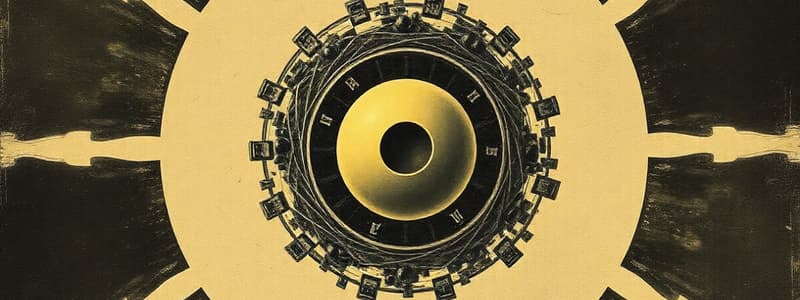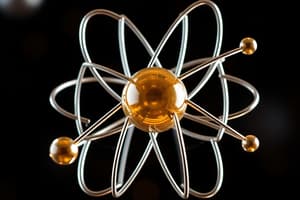Podcast
Questions and Answers
Rutherford's 1902 statement, "The changes in question are different... from any that have been before dealt with in chemistry," foreshadowed which revolutionary concept?
Rutherford's 1902 statement, "The changes in question are different... from any that have been before dealt with in chemistry," foreshadowed which revolutionary concept?
- The existence of isotopes
- The atomic nature of matter
- The quantized nature of energy
- The nuclear structure of the atom (correct)
What experimental anomaly led Rutherford to question the "plum pudding" model of the atom?
What experimental anomaly led Rutherford to question the "plum pudding" model of the atom?
- The emission of beta particles during radioactive decay
- The scattering of alpha particles at large angles (correct)
- The diffraction of alpha particles by crystal lattices
- The absorption of alpha particles by metal foils
Which observation from Rutherford's gold foil experiment directly supported the notion of a dense, positively charged nucleus?
Which observation from Rutherford's gold foil experiment directly supported the notion of a dense, positively charged nucleus?
- The absorption of alpha particles by the gold foil
- Most alpha particles passing straight through
- A small fraction of alpha particles being deflected at wide angles (correct)
- The even distribution of deflected alpha particles
How did Bohr’s model address shortcomings of Rutherford's model regarding electron behavior?
How did Bohr’s model address shortcomings of Rutherford's model regarding electron behavior?
Which crucial discovery stemmed from bombarding light elements with alpha particles?
Which crucial discovery stemmed from bombarding light elements with alpha particles?
Rutherford's analogy of the atom to a miniature solar system primarily highlighted which feature?
Rutherford's analogy of the atom to a miniature solar system primarily highlighted which feature?
What prompted Rutherford to propose the existence of neutrons?
What prompted Rutherford to propose the existence of neutrons?
The "pinball machine" analogy in the provided images serves to illustrate which aspect of Rutherford's experiment?
The "pinball machine" analogy in the provided images serves to illustrate which aspect of Rutherford's experiment?
If Rutherford's gold foil experiment had shown all alpha particles passing straight through undeflected, what conclusion would likely have been drawn about atomic structure?
If Rutherford's gold foil experiment had shown all alpha particles passing straight through undeflected, what conclusion would likely have been drawn about atomic structure?
Chadwick's identification of the neutron confirmed which of Rutherford's hypotheses?
Chadwick's identification of the neutron confirmed which of Rutherford's hypotheses?
Flashcards
Rutherford's Experiment
Rutherford's Experiment
An experiment where alpha particles were fired at gold foil, revealing atomic structure.
Atomic Nucleus
Atomic Nucleus
A small, dense region at the center of an atom containing protons and neutrons.
Proton
Proton
A positively charged particle found in the atomic nucleus, fundamental to all elements.
Neutrons
Neutrons
Signup and view all the flashcards
Plum Pudding Model
Plum Pudding Model
Signup and view all the flashcards
Gold Foil Experiment
Gold Foil Experiment
Signup and view all the flashcards
Energy Levels
Energy Levels
Signup and view all the flashcards
Quantum Physics
Quantum Physics
Signup and view all the flashcards
Rutherford's Atomic Model
Rutherford's Atomic Model
Signup and view all the flashcards
Discovery of the Neutron
Discovery of the Neutron
Signup and view all the flashcards
Study Notes
Rutherford's Atomic Model
- Rutherford's work challenged previous atomic models
- He fired positively charged particles at a thin gold foil
- Most particles passed through, some were deflected, and some bounced back
- This suggested a dense, positively charged nucleus at the atom's center
- The atom is mostly empty space
- Electrons orbit around the nucleus
Atomic Disintegration
- Atoms release smaller particles, becoming smaller
- Rutherford proposed that radiation is a product of this disintegration
- Different radioactive materials have different disintegration rates
- "Half-lives" describe the time it takes for a material to reduce by half
Inside the Atom
- Rutherford's famous discovery was made at the University of Manchester in 1907
- The accepted atomic model at the time was the "plum pudding" model (Thomson)
- Thomson's model depicted a diffuse cloud of positive charge with embedded electrons
- Rutherford's gold foil experiment challenged this model
- Calculations demonstrated that the atom's positive charge and mass are concentrated in a tiny nucleus
- Rutherford's model likened the atom to a miniature solar system
Radical Shift
- Rutherford proposed a new atomic model in 1911
- The model emphasized empty space with electrons orbiting a tiny nucleus
- The nucleus held the atom's mass and positive charge
- This was a significant leap in understanding atomic structure
Niels Bohr
- Bohr collaborated with Rutherford
- He helped clarify atomic structure and challenged the classical physics model
- Bohr proposed that electrons have specific energy levels
- Electrons can transition to higher/lower energy levels by absorbing/emitting energy quanta
Atomic Nucleus and Proton
- Rutherford discovered that nitrogen and other light elements emit hydrogen nuclei when bombarded with alpha particles
- Hydrogen nuclei, later named protons, have a positive charge
- Protons are fundamental building blocks of atomic nuclei
- Rutherford also predicted the existence of neutral particles (neutrons) to balance the positive charge of the nucleus
Synthesis of Elements
- Elements can be synthetically created in labs
- Hydrogen is the simplest element
- An element, named Rutherfordium, was discovered after Rutherford
Studying That Suits You
Use AI to generate personalized quizzes and flashcards to suit your learning preferences.




